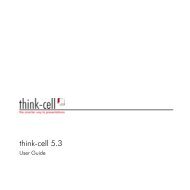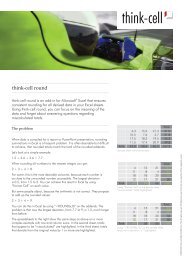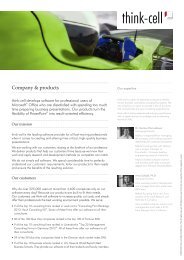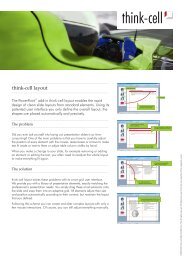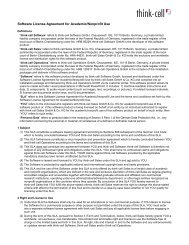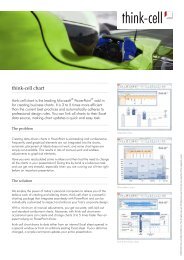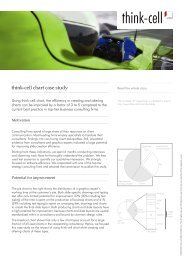think-cell technical report TC2003/01 A GUI-based Interaction ...
think-cell technical report TC2003/01 A GUI-based Interaction ...
think-cell technical report TC2003/01 A GUI-based Interaction ...
You also want an ePaper? Increase the reach of your titles
YUMPU automatically turns print PDFs into web optimized ePapers that Google loves.
5.1 Program Architecture IMPLEMENTATION<br />
driven by the document window.<br />
5.1.2 Hierarchy and Interfaces of UI Classes<br />
Some selected class diagrams are depicted in figure 38. The root class CUIObject<br />
holds a reference to its document window and offers an interface to process all<br />
kinds of low level user interface messages. The subclasses realize different UI wid-<br />
gets by implementing the processing of those messages differently. In particular,<br />
the subclasses of CHotZone offer specific functions that provide a high-level in-<br />
terpretation of the low-level UI input, <strong>based</strong> on notions like hit test, mouse capture<br />
and the like. For example, in the case of the CHotButton class, a sequence<br />
of the OnLButtonDown()/OnLButtonUp() mouse messages triggers a call to the<br />
OnClick() method, if at the times of both events the mouse pointer is found within<br />
the UI object’s responsive area.<br />
The application specific methods like OnClick() are abstract, meaning that the<br />
respective class itself cannot be instantiated. To use the functionality provided by<br />
the UI classes, each UI widget is programmed as its own subclass, implementing its<br />
specific behavior in those abstract methods. Other UI components are too specific to<br />
be derived from CHotZone or its subclasses. Examples are CFeatureOutline and<br />
CUIGridLine. These classes implement the interpretation of low-level messages<br />
themselves, deriving directly from class CUIObject (Fig. 38(a)).<br />
The inheritance graph of CVisualElement (Fig. 38(b)) partly parallels the<br />
hierarchy of subclasses of CUIObject. Most UI objects have some visual represen-<br />
tation that is made up of one or more visual elements. The methods and attributes<br />
of visual elements serve to create an appropriate texture mapping, transforming<br />
coordinates from a precompiled texture bitmap to document-oriented coordinates<br />
and finally to on-screen coordinates, taking zooming and scrolling into account. The<br />
subclasses of CVisualElement are tailored to their specific use with the objective<br />
to minimize the interface to their respective subclass of CUIObject.<br />
As can be seen in figure 37, features are contained by a smart element and<br />
smart elements are contained by a container. Now, figure 38(c)) shows that smart<br />
elements also are features and that containers also are smart elements. The class<br />
CSmartElement derives from CFeature, because the latter provides function-<br />
ality to show user interface components, and smart elements need to have a user<br />
interface, too. On the other hand, the relationship between CSmartElement and<br />
CContainerSE enables hierarchical layouts with gridlines at different levels.<br />
5.1.3 Windows Message Processing<br />
User input processing in my prototype is <strong>based</strong> on Microsoft Windows messages.<br />
In Windows, messages are responsible for inter-process communication. Messages<br />
that originate in the operating system are queued in thread-specific message queues<br />
and are processed whenever a thread makes a system call to PeekMessage() or<br />
GetMessage(). The user thread then typically makes a call to DispatchMessage(),<br />
72



